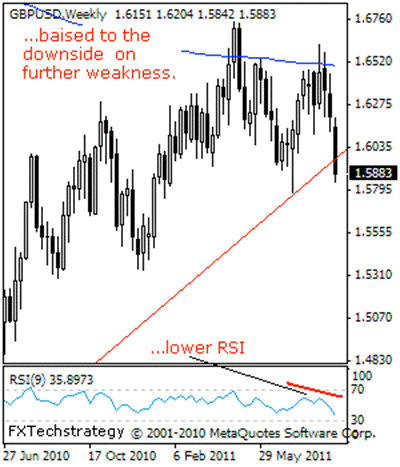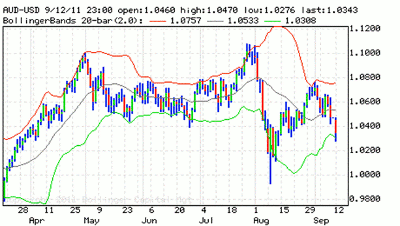The charts paint a continued bearish picture for the British pound against the US dollar, and in the Eurozone, the potential for a Greek default weighs heavily on the euro.
The GBP/USD currency pair’s continued weakness yielded a break and hold below its long-term rising trend line this past week on a weekly chart:

This is coming on the heels of its previous week losses and has now opened up further downside risk towards the 1.5778 level, its July 2011 low, and then the 1.5700 level, its round-number psychological level. Below here will set the stage for a push further lower towards the 1.5473 level.
Its weekly Relative Strength Index (RSI) is bearish and pointing lower, supporting this view. On the upside, GBP will have to break and hold above the 1.6451 level, and then the 1.6614 level to halt its present bear threats.
This, if seen, will bring further upside gains towards the 1.6743 level, the pair’s 2011 high, and then the 1.6900 level, which is another round-number psychological level.
Risk off was seen across financial markets to start the week, as the G-7 failed provide any new measures and the situation in Europe continues to look ominous.
News over the weekend that Germany was making plans for a possible Greek default ahead of October when the country is expected to run out of cash precipitated the move lower in the euro.
Rumors about French bank downgrades also hampered the market overnight. Rumors were making the rounds that BNP Paribas, Societe General, and Credit Agricole could be downgraded as early as today by Moody’s because of their exposure to Greece.
On Saturday, German economic minister Phillip Roesler wrote in Die Welt about the possibility of a Greek default and plans for an orderly bankruptcy. German finance minister Wolfgang Schaeuble added to the uncertainty when he alluded that Greece may be cut loose from the European Union.
The euro came under pressure right from the get go in Asia and tested the important 1.3500 support level where profit taking set in and the euro recovered to 1.3620.
In other news, China’s trade balance came in weaker than expected over the weekend at $17.76 billion versus the expected $24.6 billion and $31.48 billion was reported for July.
On the technical front, the Aussie dollar (AUD)—a good benchmark of the risk trade—traded through the 200-day moving average, signaling more risk aversion. The Aussie trade balance was lower than expected at 1.826 billion versus 1.9 billion expected, and a sharp revision lower was reported for the previous month.
Important News/Data to Watch
This week is a busy one on the US data front with the release of PPI, CPI, retail sales, Empire State manufacturing, industrial production, and Michigan consumer sentiment.
The EU calendar looks equally busy, as EU and International Monetary Fund (IMF) officials resume their discussion on Greece and the EU finance ministers meet in Poland to discuss how to recapitalize weak banks.
The IMF’s Lagarde is to meet Greek Prime Minister Papandreou next week and the German Parliament votes on European Financial Stability Facility (EFSF) changes on September 29.
By Mohammed Isah of FXTechStrategy.com






















